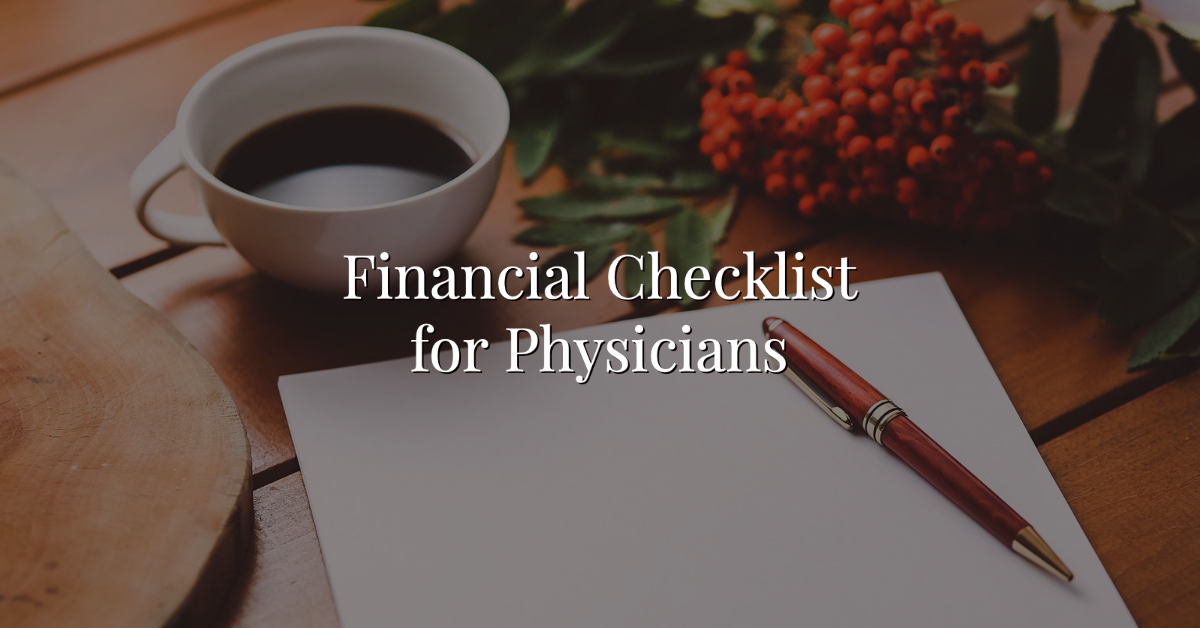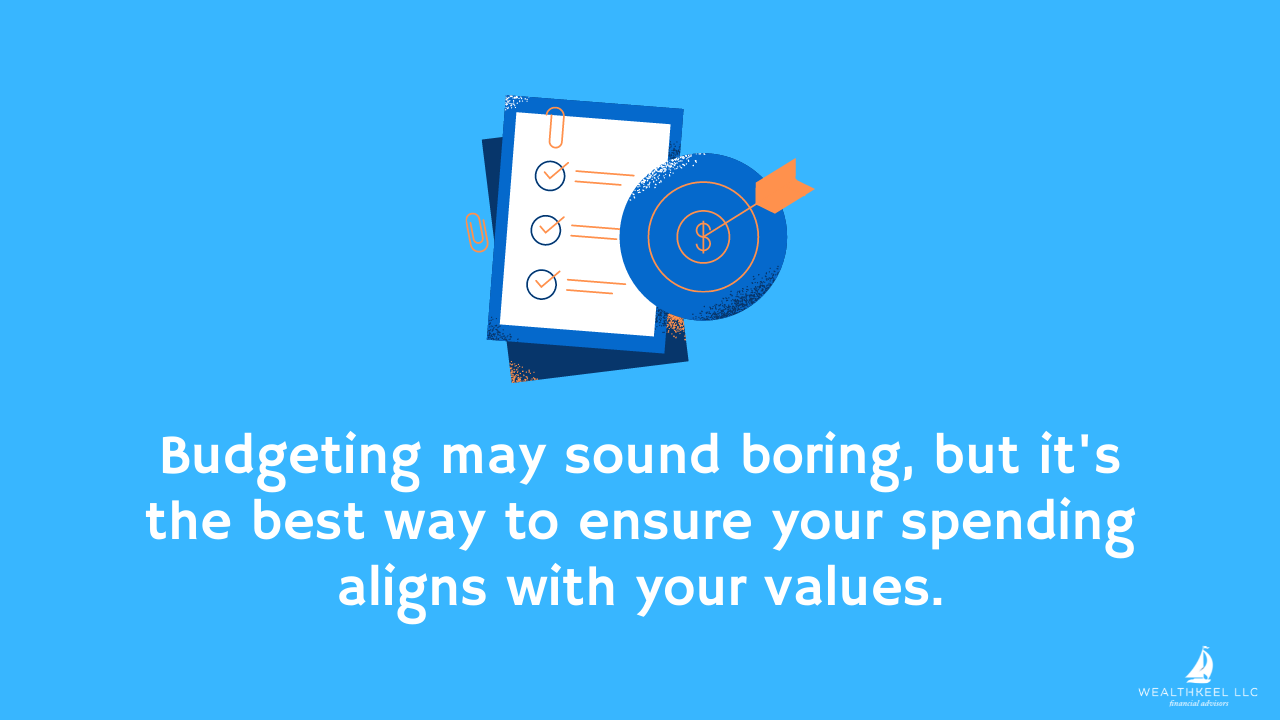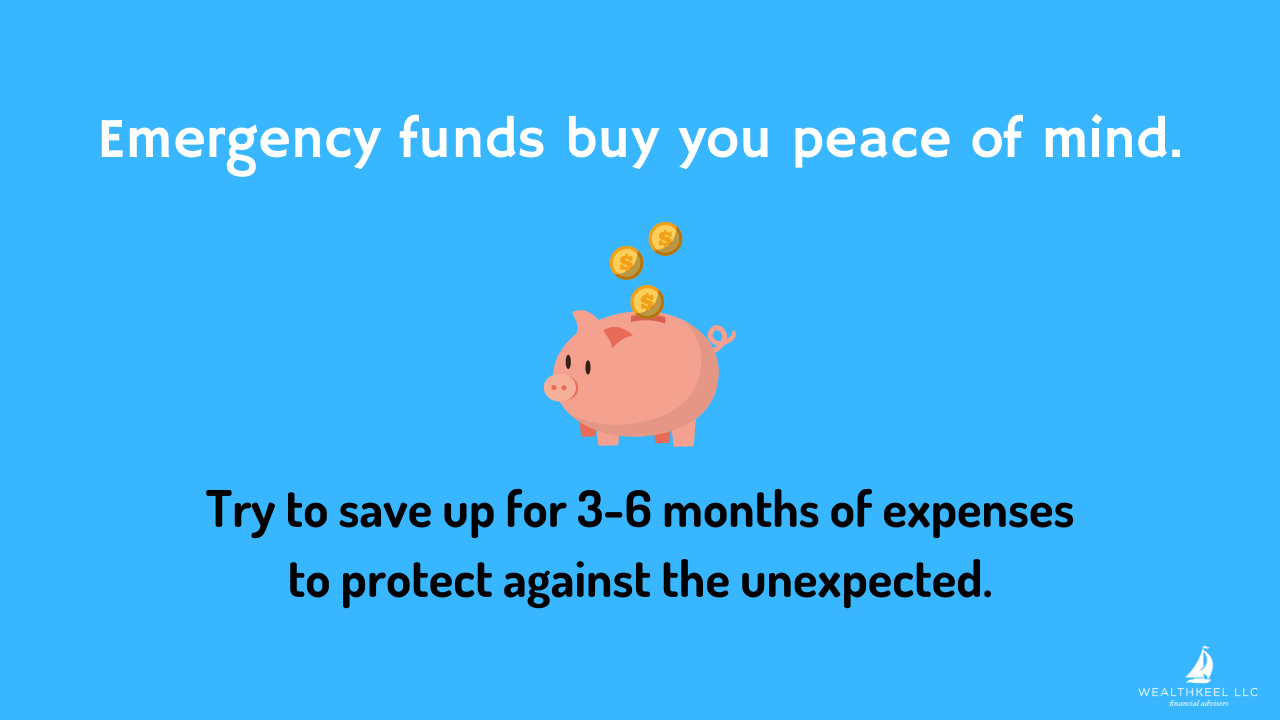We know just how hectic your life as a physician can be, which makes it incredibly difficult to complete a financial checklist for physicians, even if you know how important it is. So when you finally do get a bit of free time to yourself, we can appreciate why you continue to push off getting your financial house in order. You know it’s essential, but you can’t get yourself to invest the time it will take to get there.
One of the things that might be holding you back is not knowing where to start. With so many areas to cover, it can be incredibly overwhelming — and that can prevent you from getting the motivation to start.
In this post, we will lay out a clear checklist you can follow to help get your financial house in order. It would be impossible to cover everything in this shortlist, but it should get you headed in the right direction. It is also worth noting that you do not need to follow this checklist in this particular order. There are absolutely certain areas of greater importance that deserve more focus upfront, but these priorities will vary from person to person.
Although you will still have to do all the heavy lifting when it comes to getting your finances in order, we hope that this checklist will help serve as a starting point on your path to financial independence.
KEY TAKEAWAYS:
- Start by creating a vision for how you want to live your life. Then figure out how you’re currently spending your money to make sure it aligns with your values. Work to pay off any debt you may have.
- Obtain disability and life insurance; life rarely goes according to plan, so it’s best to be prepared by protecting your income and your family. Also, building an emergency fund will provide peace of mind for unexpected expenses.
- Choose when you would like to be financially independent. Contribute to retirement accounts with this date in mind, and consider a Backdoor Roth IRA and/or an HSA.
- Work with a qualified estate attorney to get your estate documents in order.
Prefer video over the blog? We’ve got you covered! Watch our YouTube video as we dissect this blog post for you.
1. What are your goals?
The best place to start when working to improve your finances is to create a vision of what you want your life to look like. It does you no good to start developing a plan without first thinking through where you want that plan to take you. Oftentimes, this means creating a list of goals, including both personal and financial goals.
You shouldn’t stop at creating a list of goals, however; you want to work to identify what you truly value in life. From there, you will be able to make sure your goals align with the things you value in life.
This is almost always an ongoing process. Life is ever-changing and throwing curveballs at you, which will almost certainly lead to changes in your goals and values. Reaching every goal you set is not the important part; rather, making sure your actions align with goals and your goals align with your values is what will lead to long-term success.
2. Figure out where your money is going
Before you can tell your money where to go, you need to know where it is currently going. It is crucial to get your cash flow under control, as it impacts every other aspect of your financial life.
Although it may be dreaded, the best way to figure out where your money is going and to subsequently tell it where you want it to go is to go through the process of creating a budget.
Here is a simple breakdown of what that process should look like:
- Track all of your spending for a few months
Pro-Tip: Look at tools like YNAB & Tiller to make your life easier.
- Compare your spending to your take-home income
- Review and revise
At a bare minimum, your goal should be to spend less than you make. Without doing so, you will never be able to build wealth and improve your finances.
3. Develop a plan for paying off your debt
In its simplest form, the goal of financial planning is to increase your net worth until you have reached a point at which you are financially independent.
Net worth = your assets (what you own) – your liabilities (what you owe)
Thus, there are two ways to increase your net worth: save and invest more to increase assets or pay more to your debts to reduce your liabilities. A good starting point to reduce your debt is to take an inventory of all of your debt. Write out a list of everything you owe. Be sure to include how much you owe, the interest rate of the loan, and the term of the loan. From there, you can develop a strategy of how to pay off this debt.
The numbers will say it is best to pay off the debt with the highest interest rate first and work your way down (avalanche method). However, it may make more sense from a psychological standpoint to pay off the debt with the lowest balance and work your way up, fundamentally ignoring interest rates (snowball method). While this method will result in paying more interest than the avalanche method, paying off low balances quickly can provide the motivation you need to keep knocking down your higher balances.
If you are reading this post, there’s a good chance you have student loan debt. In most cases, early career physicians have such a substantial amount of student loans that they actually have a negative net worth despite their generally high income. The first consideration to make when developing a plan to repay your student loans is to determine if you qualify for Public Student Loan Forgiveness and whether that route makes sense for you. If you decide not to go for PSLF (or any other forgiveness programs), it will likely make sense to consolidate and refinance your loans to get a lower interest rate.
It is also important to note that if you carry a balance on your credit card month-to-month, this is probably the first place you should look when working to pay off your debt. It is common for credit cards to have interest rates greater than 18%, so you want to avoid credit card debt whenever possible. If you carry a balance on your credit card, you can consider transferring that balance to a new card with a lower rate. Some cards even offer a promotional 0% interest rate when you transfer a balance to their card. However, with that said, do not get in the habit of balance transfers as part of your “financial plan” for your own sanity.
4. Obtain disability and life insurance
This is probably a good point in the post to emphasize again that this list is not necessarily intended to be followed in order. If you do not have any disability or life insurance in place, you could easily argue that this should jump up to the top of the list!
Insurance is a necessity while building wealth but is something that we hope we never have to use. This conflict raises the question, “Why pay for something that I hope to never use?” If life were to go perfectly to plan and you never received insurance proceeds, then there really would be no benefit to insurance. The problem is that life rarely goes according to plan, so it is important to understand what you are buying with insurance.
Disability insurance allows you to protect your income. If something were to happen to you that prevented you from working for a period of time or even permanently, the proceeds from a disability insurance policy would provide a replacement income to you. This gives you the peace of mind that you will still be able to reach goals you’ve set even if disaster strikes and you are never able to return to work. It is crucial to make sure you get the right type of disability insurance. You will likely have a policy through your employer, but most physicians will also want to supplement that with an individual policy with the “own occupation” definition of disability.
Life insurance is purchased to protect your family and those you care about. The protection provided by life insurance is more pronounced and assures us that our loved ones will be okay in the event of a premature death. In most cases, term life insurance is the best coverage to purchase, particularly early on in your career. (Yes, we are looking at you, insurance salesperson slinging permanent life insurance to residents!)
5. Build an emergency fund
There are many reasons to have an emergency fund, but the main idea is to protect against the unexpected, similar to insurance. The general guideline when it comes to an emergency fund is to build three to six months of expenses and to keep that money in a savings account that can be accessed when needed. This amount can change based on how stable your income is and how much you feel you need to “be able to sleep at night,” or what we call your “sleep number” (don’t tell Sleep Number we use that line…).
You should look to build this emergency fund before you get too worried about trying to maximize your retirement contributions and other investments. This account will allow you to remain invested in the future when trouble arises, and you need access to a substantial amount of cash.
6. Determine when you would like to be financially independent
This is not an easy question to answer and will almost certainly change as you progress through life. Your goal is to get to the point where you are working because you enjoy the work you do, not because you need to work for an income. Once you reach this point, you are in complete control of your time and can choose to spend it the way you want.
While this goal will change throughout the course of your life, it is still essential to think it through early on in your career. Deciding when you would like to become financially independent will allow you to determine how much you need to be saving to make that goal a reality. The sooner you start saving and the greater the percentage of income you can save, the more flexibility you will have in terms of reaching financial independence.
7. Make contributions to qualified retirement accounts
As a physician, you are in a higher income tax bracket. This increases the benefit of contributing to pre-tax retirement accounts. Making these contributions allows you to reduce your taxable income during the years you are in these higher tax brackets. While we can’t predict what future taxes will be, the hope is that when you withdraw the money in retirement, you will be taxed at a lower income tax bracket.
8. Make “Backdoor” Roth IRA contributions
Your income is likely too high to contribute directly to a Roth IRA due to tax laws. However, there is a simple workaround known as a “Backdoor” Roth IRA contribution. Currently, in 2025 you can contribute $7,000 to a nondeductible IRA, and then convert those contributions over to a Roth IRA. This is a great way to further save for retirement, while also diversifying your retirement assets from a tax perspective. Roth contributions are made with after-tax money (no upfront tax benefit) but receive tax-deferred growth and tax-free qualified withdrawals.
9. If a High Deductible Health Plan makes sense for you and your family, contribute to an HSA
If you already have a High Deductible Health Plan or believe one could be right for you, you should consider opening a Health Savings Account (HSA).
An HSA is an incredible account that has a triple tax benefit!
Contributions are tax-deductible when going out, growth on contributions are tax-deferred while in the account, and withdrawals are tax-free when used for qualified medical expenses.
Another unique benefit of an HSA is that after age 65, the funds in the account can be withdrawn for any reason without penalty. However, income tax will be owed on the withdrawal if it is not used for qualified medical expenses. This is very similar to the taxation of a Traditional IRA, which is why the HSA has gotten the nickname the “Stealth IRA.”
10. Establish important estate documents
It is crucial to work with a qualified estate planning attorney to establish crucial estate documents. Doing so will make financial transitions and end-of-life decisions as easy as possible on your loved ones if you were to pass away prematurely.
Four estate documents you want to make sure that you have in place include: a will, a living will, a durable financial power of attorney, and a durable health care power of attorney.
Hopefully, this quick checklist has provided you with a nice starting point to kickstart your path to financial independence. Go get ‘em!
Looking for a more thorough, all-in-one spot for your financial life? Check out our free eBook: A Doctor’s Prescription to Comprehensive Financial Wellness [Yes, it will ask for your email 😉]


